Industry Report
Veeva 2019 Unified Clinical Operations Survey Report
The Veeva 2019 Unified Clinical Operations Survey Report examines the life sciences industry’s progress toward a unified clinical operating environment by gathering the experiences and opinions of 461 clinical operations professionals from around the globe. The annual research details the drivers, barriers, and benefits of a unified clinical operating model and tracks the industry’s progress in its move to unify clinical systems and processes and align stakeholders throughout study execution.
Executive Summary
Findings show the industry is making progress in unifying clinical systems, streamlining end-to-end processes, and aligning stakeholders to improve trial performance.
- Standalone, eClinical applications, including EDC (88%), eTMF (69%), and CTMS (61%) are now utilized by the majority of sponsors and CROs as they steadily adopt function-specific technologies to support clinical trials.
- Nearly all (99%) respondents report the need to unify clinical applications to achieve better visibility and oversight (70%), faster trials (63%), and easier stakeholder collaboration (61%).
- Consistent with the aim to improve collaboration, all respondents say they want to improve methods of information exchange between sponsors, CROs, and sites. Primary reasons include reduced manual processes (71%), improved collaboration (66%), and better visibility and oversight (64%).
- All respondents report significant challenges with study start-up, likely due to the heavy reliance on manual processes since most (81%) use spreadsheets to manage this area.
- Sponsors and CROs have made progress modernizing major clinical areas such as eTMF to ensure a constant state of inspection readiness (60%) and increase visibility into TMF status (58%).
- Most respondents (95%) cite the need to improve the use of CTMS in clinical operations. Top drivers are improved reporting (68%), increased visibility (60%), and more proactive risk mitigation (58%).
The State of Unifying Clinical Systems, Processes, and Stakeholder Collaboration
The life sciences industry is experiencing rapid innovation and bringing novel drugs to market at an accelerated pace. In 2018, the industry achieved a record-setting number of 59 drug approvals, compared with 46 approvals in 2017, and 22 in 2016.1 As the speed of breakthrough drugs and treatments continues to accelerate, organizations will have a greater need for improved trial efficiency and visibility.2
Over the past several years, sponsors and CROs have steadily adopted function-specific technologies to improve study execution. Highest is EDC, used by 88% of CROs and sponsors surveyed. More than two-thirds (69%) have eTMF applications, up from 57% in 2017. RTSM applications (63%) increased 21-percentage points, likely due to rising protocol design complexity.3
Majorities also use CTMS (61%) and safety applications (53%). Nearly one-quarter (23%) have now adopted newer, purpose-built study start-up applications.
Applications Used to Manage Clinical Studies
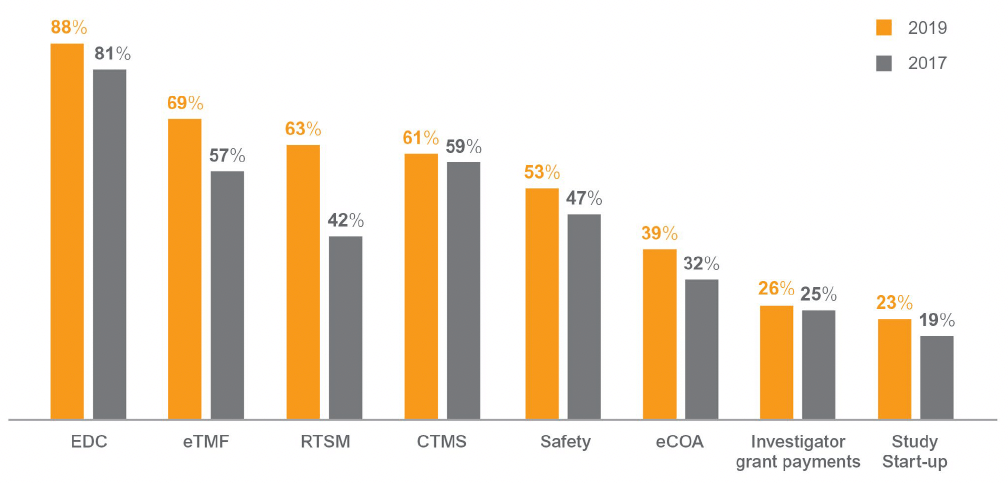
Drivers and Barriers to Unifying Clinical Systems and Processes
Nearly all (97%) respondents say they have at least one major challenge with their clinical applications, and more than three-quarters (83%) have two or more challenges.
The top two issues – integrating multiple applications (68%) and reporting across multiple applications (57%) – are the direct result of clinical application silos.
Biggest Challenges with Clinical Applications

With the focus to improve clinical operations, nearly all respondents (99%) say they need to unify their clinical trial systems and processes. For more than half, the need to unify is driven by better visibility (70%), faster study execution (63%), easier collaboration (61%), and improved study quality (56%).
Top Drivers for Unified Clinical Applications

Information Exchange in Clinical Trials
As sponsors increasingly contract the specialized services of multiple CROs in a single study, information sharing is difficult because of the many different processes and systems used across stakeholders.4
All respondents (100%) report the need to simplify information exchange with study partners. The primary drivers are reducing manual processes (71%), improving collaboration (66%), and increasing visibility and oversight (64%).
Top Drivers to Streamline Information Exchange

Respondents use a variety of tools to exchange trial data and documents with study partners. On average, sponsors and CROs use three methods for information exchange, and one-quarter (25%) use at least four methods.
Email is the predominant way sponsors exchange information with CROs (78%), followed by portals (51%), file share (51%), and eTMF applications (38%).
Less than one-third of sponsors rely on ECM applications (29%) or paper shipments (25%) to exchange trial information with CROs.
Methods Used by Sponsors to Exchange Information with CROs
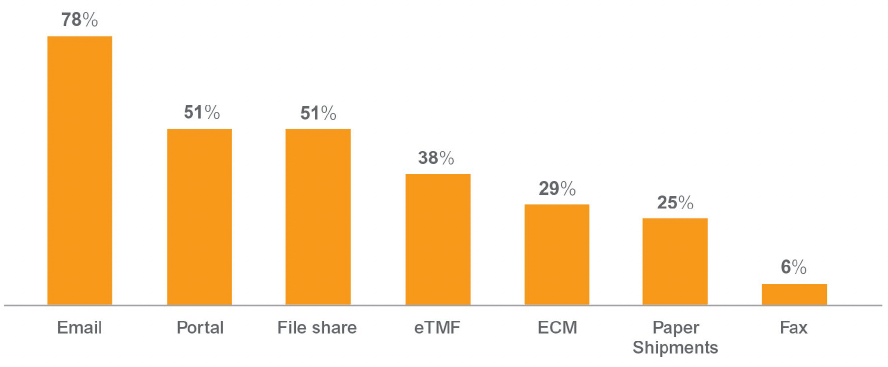
Sponsors and CROs utilize different methods to exchange information with sites, adding further complexity in data sharing and collaboration.
Half of CROs (50%) and one-third of sponsors (35%) use paper shipments to manage information exchange with sites, followed by portals (44% versus 41%, respectively), and eTMF (39% versus 27%, respectively).
Methods Used by Sponsors and CROs to Exchange Information with Sites
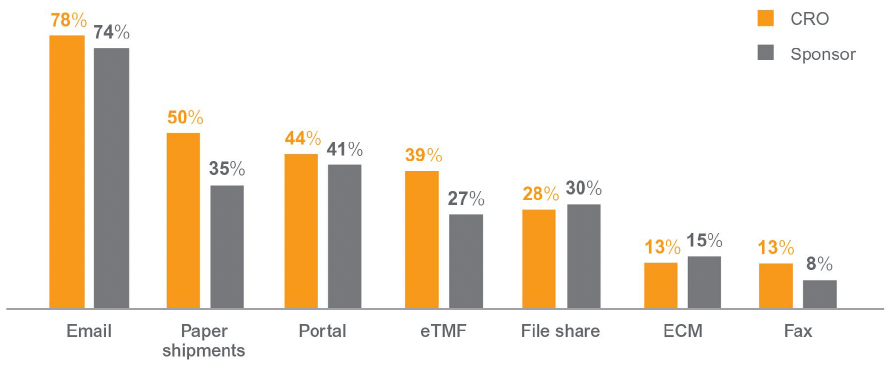
The majority (96%) of respondents say they have significant challenges with the methods used to exchange information during clinical trials.
Collecting data in different systems increases manual effort, causes duplicate data entry, and limits visibility. These difficulties can contribute to issues respondents have with tracking and reporting (71%), misfiled or missing documents (57%), and manual document exchange (47%).
CROs are more likely to report challenges with misfiled documents (59%) and redundant data transcription (43%) than sponsors (54% and 33%, respectively). The higher use of paper and email to exchange trial documents with sites could contribute to these differences.
Sponsors report more challenges complying with standards (29%) than CROs (18%) perhaps, in part, due to sponsor responsibility for adherence to good clinical practice guidelines (GCP) required by ICH E6 (R2).5
Biggest Challenges with Information Exchange
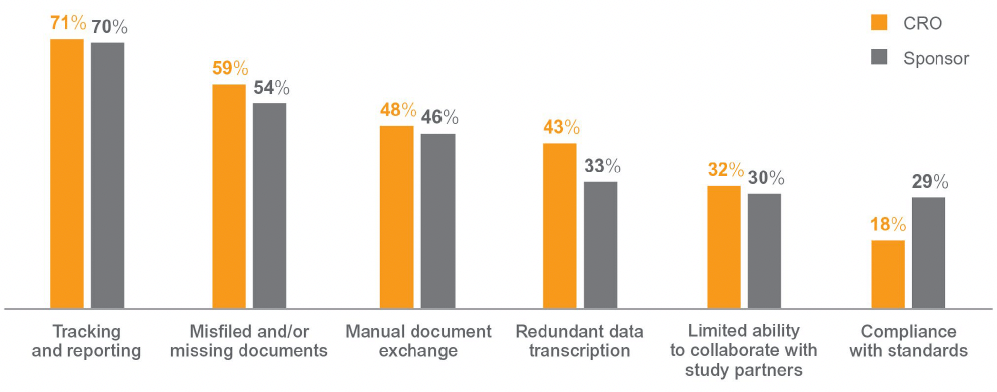
Accelerating Study Start-up
The resource intensive study start-up phase of clinical trials is no faster today than a decade ago.6 Most trials (86%) experience delays in meeting start-up timelines, costing sponsors up to $2M per month.7
Tufts Center for the Study of Drug Development (CSDD) research shows that cycle times can be significantly delayed due to paper-based processes and multiple handoffs.8 Consistent with these findings, all survey respondents (100%) report challenges with the study start-up process.
Site contracting and budgeting accounts for most of the cycle time and takes twice as long today than five years ago.9 Roughly three-quarters of sponsors and CROs (73%) say site contracting and budgeting are their most challenging study start-up processes, up 20-percentage points since 2018.
Half (49%) say site identification and selection is a top challenge limiting their ability to speed trials, followed by IRB/ethics committee approval and planning (42%).
Biggest Challenges with Study Start-up Processes
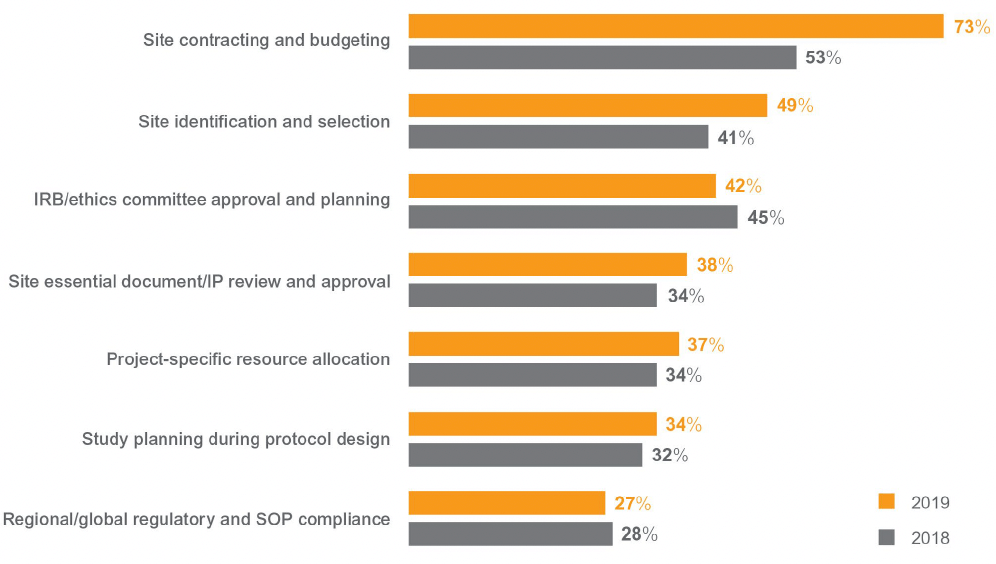
For most, faster study start-up times (71%), streamlined site contracting and budgeting (60%), and better site feasibility and selection outcomes (52%) are the primary drivers to improve study start-up.
Half (50%) say easier collaboration between sponsors, CROs, and sites is essential to improve study start-up, highlighting the importance of collaboration in driving greater speed and efficiency.
Top Drivers to Improve Study Start-up Processes
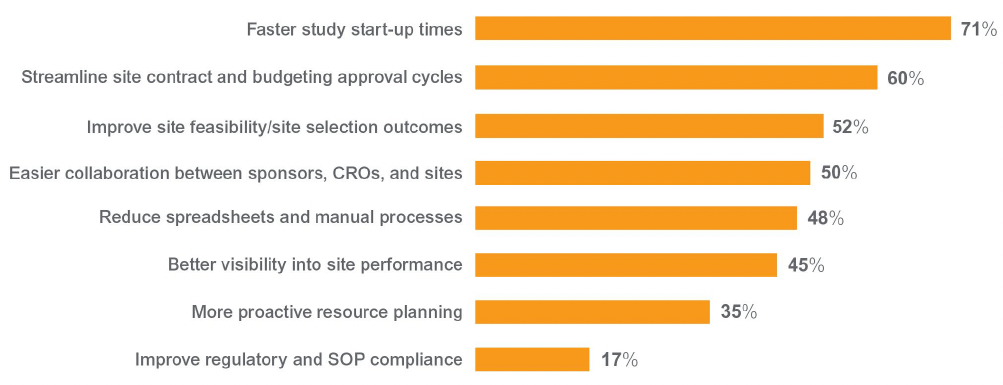
Most (81%) use spreadsheets to manage study start-up. Roughly one-third or less use CTMS (38%), eTMF (35%), internally developed applications (29%), or online survey tools (25%).
Significantly more CROs than sponsors utilize newer, purpose-built study start-up applications (28% versus 12%, respectively). This may be due, in part, to the increase in outsourcing of study start-up activities to CROs.
Tools Used to Manage Study Start-up Processes
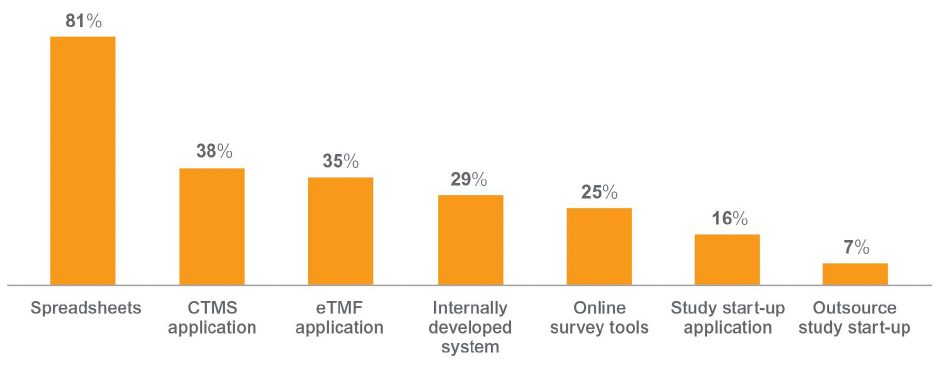
Active TMF Management and Oversight
Over the past five years, sponsors and CROs have made significant progress modernizing trial processes with the adoption of purpose-built eTMF applications which can help ensure a constant state of inspection readiness, increase visibility and oversight, and improve collaboration.10
The number of respondents using an eTMF application has tripled since 2014. More than half of sponsors and CROs (56%) now use a purpose-built eTMF application, versus 17% in 2014.
eTMF Application Use 2014-2019
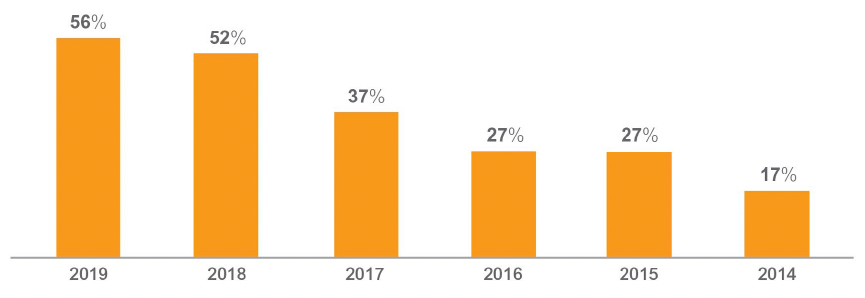
The increase in the use of eTMF applications is matched by a sharp decline in the use of content management systems, signaling a shift away from general-purpose methods to manage TMF processes. Today, only 8% use content management systems for TMF management, versus 31% in 2017.
TMF System Used
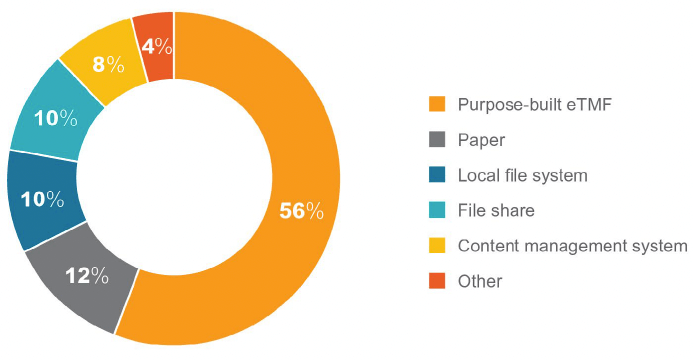
Findings indicate the move from TMFs which act as static repositories to store and archive documents upon completion, to modern purpose-built eTMF applications is enabling more ‘active’ trial management. Likely because these newer applications automate processes and manage documents as they are created and reviewed, ensuring the TMF is maintained in a constant state of inspection readiness.
Those using purpose-built eTMF applications report a significant, positive impact on inspectionreadiness (60%), increased visibility into TMF status (58%), and centralized auditing (36%). They also report fewer challenges complying with standards (8% for purpose-built TMF users versus 31% using other methods) and TMF tracking and reporting (47% versus 64%, respectively).
Benefits of a TMF by Type of TMF
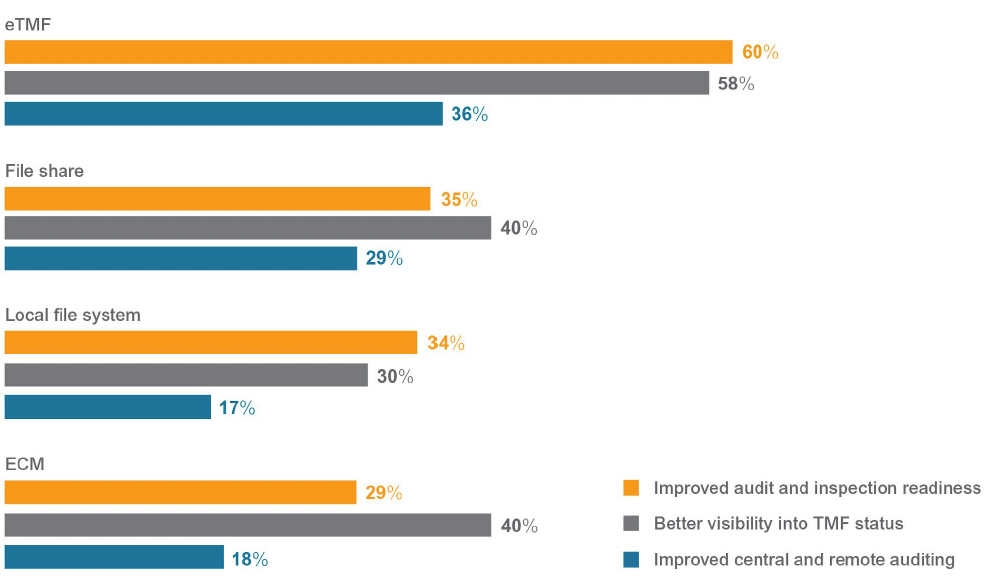
Improving Clinical Trial Performance
CTMS applications enable a centralized view of study progress, requiring interoperability with other clinical systems to support timely decision making, oversight, and streamlined communication among stakeholders.11
Nearly all sponsors and CROs surveyed (90%) say they have at least one major challenge with their CTMS application that limits operational efficiency, and three-quarters (74%) have two or more challenges. A number of respondents noted multiple, compounding issues:
“Our CTMS system has a poor user experience, technical malfunctions, slow response times, is difficult to integrate to multiple data sources, and lacks feasibility reports and tracking.”
Integrating CTMS applications with other clinical systems (63%) and study performance metrics and reporting (53%) are the challenges most frequently cited.
One-third say CTMS application issues limit efficiency of key trial processes, including monitoring (38%), resource management (36%), and issue and task management (31%).
Poorly integrated CTMS systems also prevent stakeholders from getting a complete view of study progress and contribute to the difficulty with governance and oversight (29%).
Biggest Challenges with CTMS Applications

Likely due to the significance and prevalence of challenges, nearly all (95%) say they need to improve the use of CTMS in trial operations. Better analytics and reporting (68%), increased visibility (60%), and proactive risk identification and mitigation (58%) are among the top reasons to improve.
Easier internal and external collaboration is also a top driver for roughly half of sponsors and CROs (48%), underscoring the importance of streamlining communication and information sharing during study execution.
Top Drivers to Improve Clinical Trial Performance

Conclusion
This research shows that unifying clinical operations and aligning stakeholders remains an important priority for sponsors and CROs. While there is work to do, the industry has made progress in moving toward a unified clinical operating model which is having a significant, measurable impact in:
- Speeding study start-up: Study start-up has emerged as a major area of focus for sponsors and CROs alike. With it, the adoption of study start-up applications is on the rise and is reducing cycle times by eliminating manual processes and streamlining stakeholder communication – bringing a higher level of predictability, quality, and speed to clinical trials.
- Increasing study quality and compliance: Positive change is underway as the industry unifies and modernizes its TMF processes for active TMF management and oversight. As documents are managed in real-time as the TMF is generated, a constant state of inspection-readiness is achieved, leading to significant gains in compliance, visibility, and process improvements that streamline the entire study process.
- Eliminating silos: There is tremendous opportunity to reduce system and process fragmentation that limit trial performance and slow execution. Modern clinical trial management systems on a unified platform eliminate silos, improve study visibility, and enable centralized monitoring and oversight needed to effectively manage and optimize trials.
- Streamlining information exchange and collaboration: The ability to exchange information easily is one of the greatest areas of opportunity for improving how sponsors, CROs, and sites work together in clinical trials. Unified processes and systems streamline stakeholder communication and collaboration. The exchange of trial information is simplified (and where possible, automated), and study progress is made visible to all parties in real-time, ensuring stakeholder alignment and improved trial performance.
There is universal recognition that a unified clinical environment is essential to transforming clinical operations – and the industry has made steady progress toward that goal. The resulting gains in efficiency, visibility, and quality will enable the industry to rethink how studies are conducted – and adopt new and more effective business models that drive trial performance, simplify data sharing and collaboration, and ultimately, accelerate delivery of breakthrough drugs and treatments to market.
Survey Methods
The survey consisted of 16 questions, many of which included sub-questions with response matrices. Survey questions were designed for individuals with knowledge of clinical operations processes and with partial or full responsibility for clinical operations within their organization. The survey was commissioned by Veeva Systems and conducted by Fierce Markets, Applied Clinical Trials, and Veeva Systems. Completion of the survey was voluntary. Respondents received a $5 or $10 Amazon gift card and were offered a summary of survey results. No other compensation was offered or provided.
Survey Respondents
Of the approximately 270,020 individuals invited to take the survey, a total of 2,484 surveys were initiated, the majority of which were terminated based on a qualification question gauging the level of responsibility for clinical in their organization. More than 830 unverified responses were eliminated, yielding 461 qualified responses.
Survey Respondent Demographics
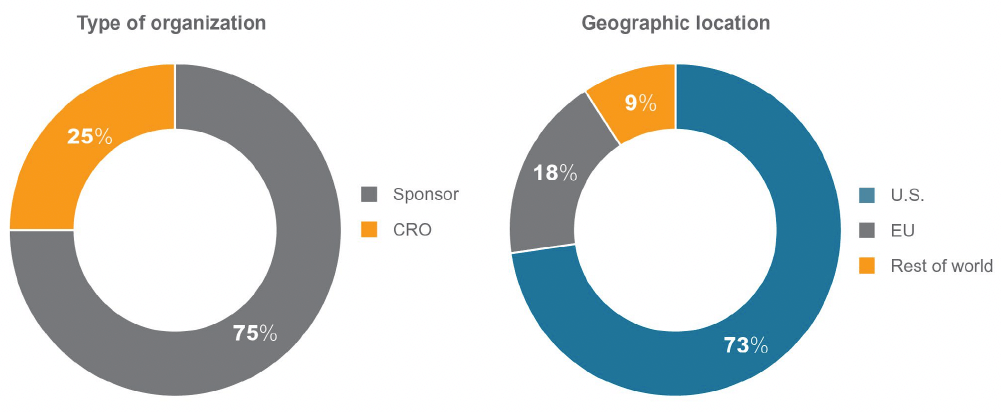
2 U.S Food & Drug Administration. FDA Statement on New Strategies to Modernize Clinical Trials. March 2019.
3 Getz KA, Campo RA. New benchmarks characterizing growth in protocol design complexity. Therapeutic Innovation & Regulatory Science. 2017.
4 DIA Global Forum. The Next Big Step Toward a Collaborative Clinical Ecosystem. October 2018.
5 Integrated Addendum to ICH E6 (R1): Guideline for Good Clinical Practice E6 (R2) 2016.
6 Lamberti, MJ, Chakravarthy, R, Getz, KA. Assessing Practices & Inefficiencies with Site Selection, Study Start-Up, and Site Activation. Applied Clinical Trials, August 2016.
7 NCBI. Brianna M Krafcik, Gheorghe Doros, Mariana A Malikova. A single center analysis of factors influencing study start-up timelines in clinical trials. July 2017.
8 Applied Clinical Trials. The Need and Opportunity for a New Paradigm in Clinical Trial Execution. June 2018.
9 BioSpace. Site Contracts from Weeks to Months: Results from KMR Group’s Site Contracts Study. August 2016.
10 Veeva 2018 Unified Clinical Operations Survey. Top drivers to optimize TMF processes. (Q13).
11 First Analysis Securities Corporation. eClinical Solutions: Streamlining the introduction of new drugs and medical technology. January 2018.